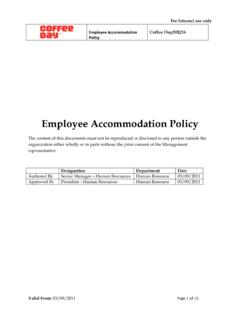Transcription of Backup and Recovery Best Practices
1 Backup and Recovery best PracticesThere are many risks to your data, including hardware failure, natural disasters, human error, theft, and attacks such as malware and ransomware. You might not be able to anticipate every data risk, but a strong Backup and Recovery plan will help you quickly return to operation. Here are three things you can do in your role to #BeCyberSmart. CYBERSECURITYis everyone s updated June 2020 SECURITYCYBERC ybersecurity considerations for local government leadership2 This short guide to leading Practices for data Backup and Recovery draws on the experience of the State Auditor s Office and experts such as the National Institute of Standards and Technology (NIST) and the Center for Internet Security (CIS).
2 1. Define your expectations and intent in a policy A policy over Backup and Recovery communicates your expectations and the goals for protecting the government s data and assigns responsibility to ensure it happens. Are particular systems critical to your operations? If so, you might want to save multiple copies of your data in case access to your system and Backup is prevented by a ransomware attack. If your data or systems were damaged, could you manually re-create all of your transactions? If not, you might want to make a Backup very frequently.
3 2. Establish a strategy to communicate how you intend to implement the policy The Backup strategy may be incorporated in the policy or your procedures, or may be a separate document. The strategy is generally the responsibility of management (CIO/CISO/IT manager) and contains guidance to implement the expectations and goals you set in your policy. The strategy can depend on multiple factors, including specific departmental Backup needs. An effective Backup strategy addresses: Who is responsible for implementing, managing, maintaining, and verifying the system works as planned What data or systems should be backed up Where the Backup should be located onsite, offsite, or in the cloud When and how often data or systems should be backed up.
4 Data with no paper record must be backed up more frequently, while data that changes infrequently or is easily created can be backed up less frequently. How the Backup files will be protected. For example, is the Backup physically protected, and do only authorized users have access? how long the Backup files will be kept . For critical backups, you might want an additional copy maintained offsite to protect the data in the event of a regional disaster or ransomware. 3. Establish a documented plan or procedures to ensure consistent implementation The Backup procedures are the steps used by your IT staff to implement the Backup strategy.
5 Clearly documented steps identify the procedures to initiate, schedule, and validate each Backup to ensure data has been saved. These procedures will also help you manage the process during employee absence or turnover. An effective Backup procedure will include: Backup schedules. The frequency of the Backup will be defined based on your strategy. If you use an automated Backup system, the schedule 1 Implement a strong Backup processLeadership and Planning32 Now that your data is backed up safely, the next step is to ensure you can continue operations while you recover your data from your Backup .
6 The key to ensuring your government can rebound from a natural disaster or cyberattack is being able to quickly recover your most important data. There are two plans that address different aspects of ensuring speedy Recovery of data and operations: A business continuity plan helps you continue all aspects of business operations during and immediately after a disaster. This can include plans for operating using manual records, establishing functionality to work remotely, defining alternate emergency office locations, and recovering data needed for critical operations during the disaster.
7 A disaster Recovery plan focuses on how a government responds and returns operations back to normal once the event has concluded, with a focus on information and technology. This can be included as part of a business continuity plan, or presented separately. 1. Identify your most common significant disaster risks Identify all the risks that can affect operations and carefully consider how they could affect your organization. Ransomware is a significant risk for most governments. In Western Washington, a major earthquake or flood is a significant risk.
8 In Central and Eastern Washington, wildfires and floods can be significant risks. Establish effective Recovery plansmay be established in the system itself. We still recommend documented procedures supporting this setup. They can be used to periodically validate the system settings and for Recovery if the Backup process fails. Tracking and monitoring. It s important to document when the backups occur. If you are using an automated Backup system, a report might identify what information was backed up and when. Review of this report will help detect any failed backups.
9 Periodic verification that the Backup can be recovered. It isn t uncommon to think your Backup is working well, only to find out it didn t run or cannot be recovered. A periodic test to recover the data will ensure your data will be ready when you need it. Performing routine inspections on Backup equipment will also help identify issues before it s too late. Here is a resource to consider: Department of Homeland Security Cybersecurity and Infrastructure Security Agency Pros and cons of Backup options for your data Data Backup OptionMunicipal Research and Services Center (MRSC) Sample plans and policies available to local governments Cyber Security Resources for State & Local Govern-mentsNational Cybersecurity Society Guidance on developing a data Backup policy Data Backup Policy Template Leadership and Planning42.
10 Evaluate your Backup and Recovery plans relative to your significant disaster risks There is no one-size-fits-all plan. The process for Recovery will vary depending on what happened and how you implemented your backups. Consider whether your Backup solution(s) will support your Recovery for the risks you identified. Consider storage location. A Backup stored locally on disks or tape is easy to quickly restore but could be destroyed by the same fire that destroyed your normal operations. A Backup stored with a cloud provider or an external vendor might protect your Backup from a regional event.



